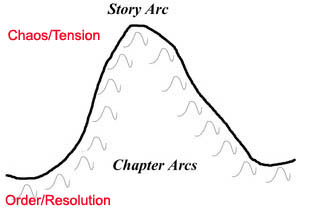« Driving sound. From the back. |
Main
| Don't mean a thing. If it ain't... »
 September 12, 2013 | Best of JM: Compose yourself. Story Arcs September 12, 2013 | Best of JM: Compose yourself. Story Arcs
Enjoy the popular archive material below.
From July 1, 2010 | Compose yourself. Story Arcs
The second in our series on "intentional" improvisation (Antecedent/Consequence last week) holds interesting concepts parallel to dramatic writing or screenplay, the notion of the Story Arc. Simply put, you start with something serene, introduce chaos, and through the course of the script, bring things to resolution.

Of course within that big picture, you have the more intricate details of subplots and character development, but still the best writers glue all these pieces to a great big mental story board. Boy meets girl, falls in love, has to fight for her attention, boy marries girl. Within that narrative is a myriad of twists and turns, the parents are against the idea, the boy can't shape the emotional baggage and behavior-shaping of a bad childhood, a hurricane threatens to destroy the town. These are all the diversions within the larger whole.
So what elements in music do we have that create similar twists and turns when our soloing needs to recount? When you are building your improv, you can certainly use the components of gravity notes and chord tones for the "subplots" of the music. The 4th and the 7th scale degrees, the surrounding chromatic passing tones leading to chord tones, all the melodic tension we cover in music theory can bring those moments of harmonic drama. This is the "character development" of the line.
Note frequency is something to consider. The worst thing you can do is come out of the gate and immediately unload machine-gun style, all your best rapid-fire licks in the first few phrases of your solo. You need that audience "foreplay" to get them warmed up to your musical ideas, plus you don't want to save your least interesting materials for last. Build by starting with slower notes and lots of Miles Davis inspired space. Save the thick black notes energy for the middle or towards the end of your solo.
Register shifts can be a fresh way to tell a story, and it's very graphical on the fretboard. Sure you want to bounce around the frets, but for heaven's sake, the mandolin can be a very shrill instrument, and dwelling up above the 12th fret can be hard on the ears. Save it for "punctuation," spice, and energy.
Dynamics are a no-brainer. Make your softs softer, your louds louder, and find the colossal range of nuance in everything in between. Remember you draw people in by playing quietly, you pound on them playing loudly. They only want so much decibel abuse and they can start tuning you out. Dynamic variety equals sophistication.
Lastly, use recurring themes and motif tidbits. We mentioned this last week about developing antecedent/consequent phrasing. Start with a simple idea and play with it, a scene and keep coming back to it, develop it. Don't just blow.
Nobody likes a drama queen when she's overly dramatic, unintelligible, and narcissistic. Spin a clear story that works the audience, not just yourself.
Further:
Compose yourself. Antecedent/Consequent thinking
Forsaking the notes for the music.
You may quote me on that.
Sitting on the edge of their seats
Dynamic Results
Posted by Ted at September 12, 2013 8:16 AM

Disclaimer: In the 'Information Age' of the 21st Century,
any fool with a computer, a modem, and an idea can
become a self-professed 'expert." This site does not
come equipped with 'discernment.'
|



